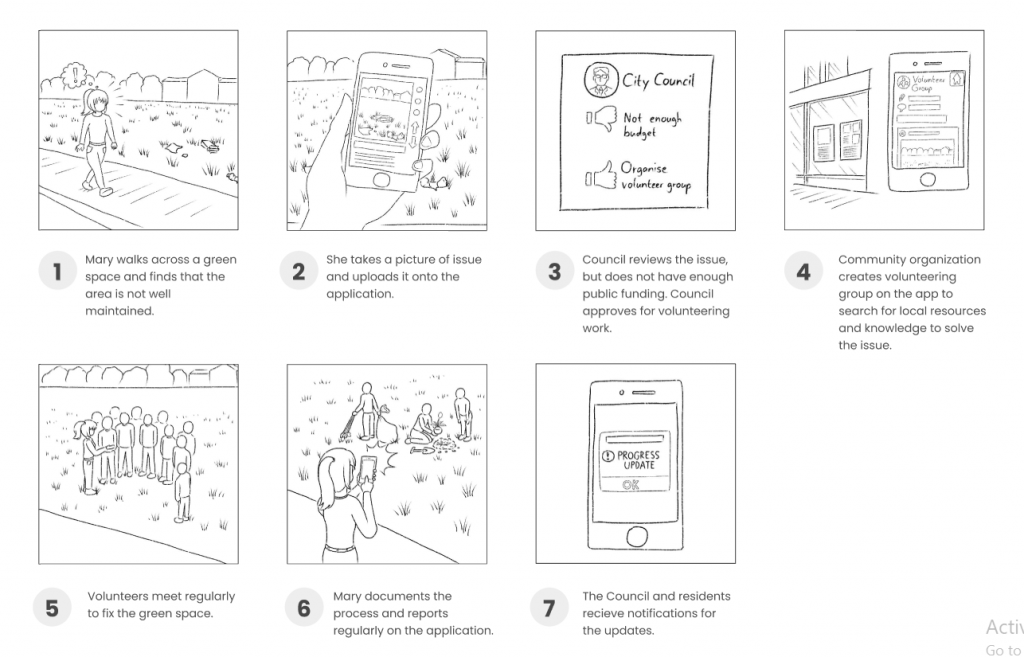This blog entry will introduce the readers to the work and presentation that our Digital Civics group has made during week six of the project. It will introduce the storyboard sketches made in the seminar session; there will be an upload of a final storyboard that our group has decided to present (Figure 1). Furthermore, the text below will include a discussion about the context of the use of our prototype, its entry and exit points and what the users would be able to do with it. This post will mention how the storyboard relates to user research; what is more, it will quickly describe how our mid-term presentation was presented and how the feedback that we got will be addressed.

The seminar session this week helped our group to understand what exactly a storyboard is and how it should look including its sketches and a finished draft. “Storyboarding is a common technique in HCI and design for demonstrating system interfaces and contexts of use.” (Storyboarding: An Empirical Determination of Best Practices and Effective Guidelines, 2020) During the seminar, we produced three different sketches of a storyboard. Our main goal was to produce different situations with different user personas, which would enable us to further understand how our prototype would work in various situations. In other words, we did not want to make a prototype idea and then test it just in one scenario; we wanted to test different scenarios and how they would evolve into a story that could be made into a storyboard.
The final storyboard draft used a persona which was likely to be involved in community organizations, is a middle class, middle-aged woman (the persona square in the storyboard will be added later in the project). The context of use in this storyboard can be seen quite clearly while looking at the storyboard. The idea behind it is that a person, who is socially active in his or her neighborhood, sees a problem that should be addressed by the council or by people around the problematic area. In the storyboard, our group used an example of an unmaintained green space. The persona who sees that space notices it and takes a photo to upload it to our prototype idea, an app that lets people share issues around Bensham, the area in Gateshead which the prototype is designed to help make a better place to live in. The storyboard then visualizes how the persona can make a change to such place. The app sends information to the local council and shares it with other users as well as the Bensham community group. Then the council decides if it has the finances and required resources to solve the issue; if not, the Bensham community group will then organize volunteers who will solve the issues without the help of the council.
Our group’s storyboard has been influenced by the user research we have done throughout the project. We have done the research with interviews with local residents, council representatives and site visits. The data produced from this helped us to understand more deeply the problems with the area of Bensham and what the residents want to be happening in the following years. Furthermore, the interviews with government representatives helped us to understand what kind of aid and cooperation we could expect as well as what is happening in Bensham nowadays. With all this information gathered It was quite clear that we had to do a storyboard about a prototype app that help to clean up and maintain safe and welcoming urban spaces in the area of Bensham.
Our mid-term presentation this week has been done with relatively positive feedback. All our group has had a say in the presentation and everyone was feeling that they have something to say and talk about. During the presentation, we introduced our team, talked about project context, the main purpose of it, user and digital application research and tried to show how our prototype would look like in the following weeks.
To summarize, the work that was produced during week 6 has really helped our project to go into the prototyping stage. We have agreed on further work needed to develop the project to be fully presentable in the final pitch.
Mindaugas Rybakovas
Bibliography
Citeseerx.ist.psu.edu. 2020. Storyboarding: An Empirical Determination Of Best Practices And Effective Guidelines. [online] Available at: <http://citeseerx.ist.psu.edu/viewdoc/download?doi=10.1.1.110.6354&rep=rep1&type=pdf> [Accessed 7 April 2020].